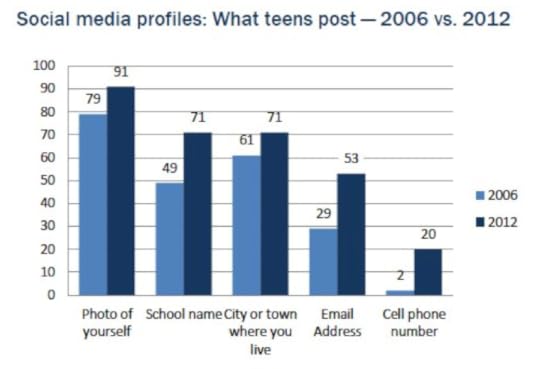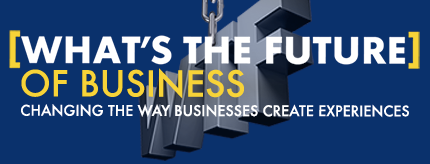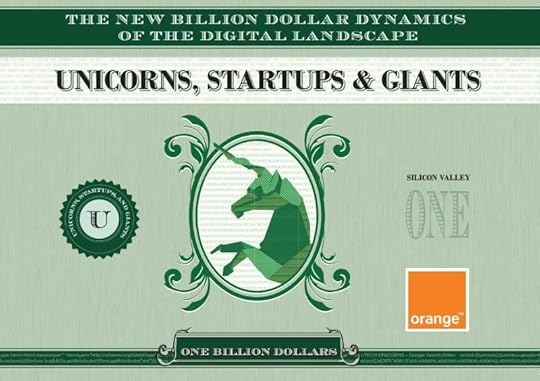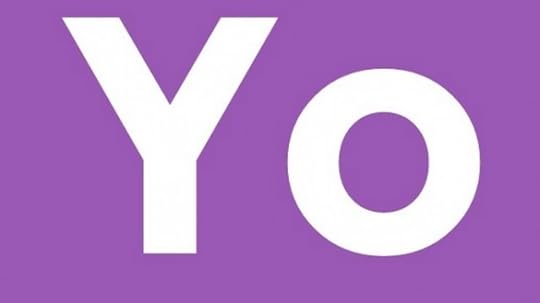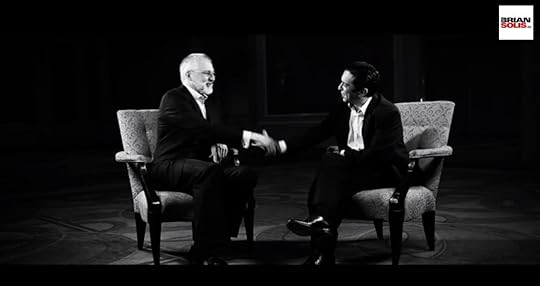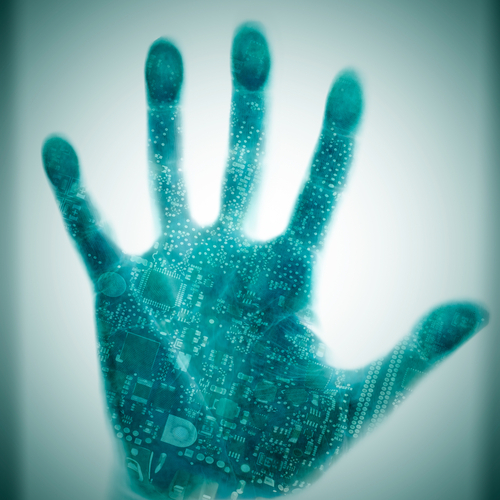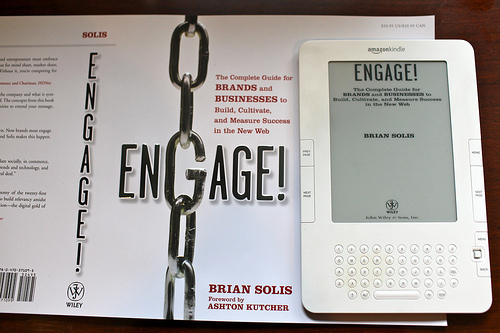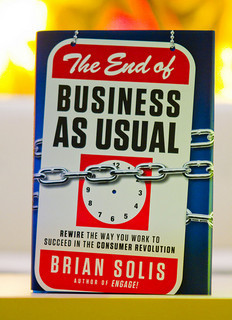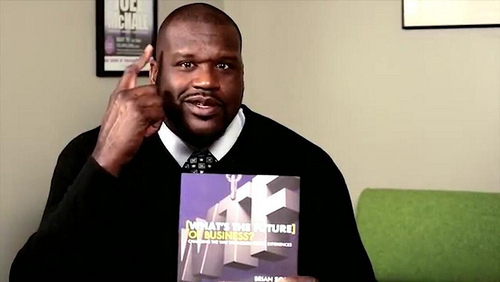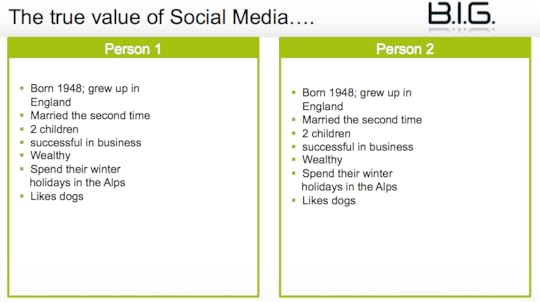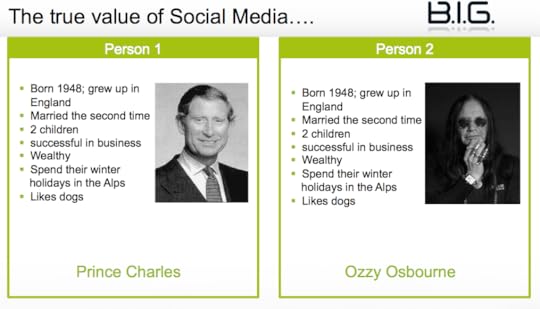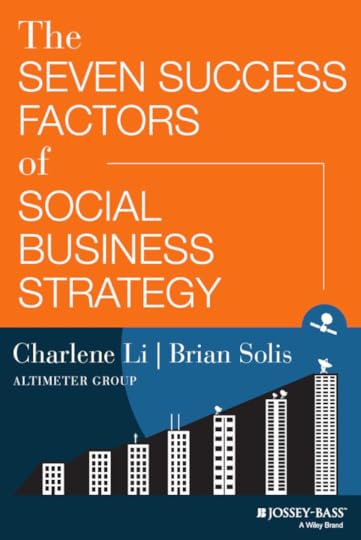Brian Solis's Blog, page 110
July 2, 2014
Broadcast Yourself(ie): If You Think Gen Y is Different, Wait Until You Meet Generation Z
How teens use social media and why it matters to you. Generation Z = (Today’s Teens, Preteens and Children)
If you want a glimpse of the future of technology and its impact on society, study how younger generations interact with one another today. While everyone is talking about Millennials these days, there’s another, potential more disruptive generation behind them…Generation Z.
With the sting of a face palm, you’ll experience a sheer rush of humility as you realize that everything you thought you knew about tech, behavior, and common sense is simply nascent compared to the native differences inherent to digital natives. No matter how connected you are or how many followers or friends you have online, there’s a sense of artistry mashed together with counter intuitive behavior that just works.
My advice to you is to study it. Study it right.now. Don’t try to make sense oft it. Don’t question it. Don’t try to make it fit into your world. Simply try to understand it. Doing so opens the door to alternative perspectives, which can lead to meaningful insights. And, this allows you to make decisions about the future without letting your predispositions or assumptions lead you in fallacious directions.
The point is this, for those that need a TL;DR version…perspective and empathy allow you to appreciate and lead not only for Gen Y and Gen Z but also everything that’s changing in between. It’s about leading through resilience.
To help Pew Research Center published an interesting study that examines teens’ social media privacy management and overall behavior. Why is it important? Well, for starters, social and mobile for teens (aka digital natives) is simply a way of life.
A Crazy Little Thing Called Privacy
If you think about it, Generation X and to some extent the older side of Generation Y, are the last to know privacy as it was. Privacy for the most part is something that older generations guarded. For most, privacy was and is sacred, worthy of protecting. Publicity on the other hand was almost a luxury. To earn the attention of the masses required investment and strategy. It’s almost the opposite is true among digital natives. Privacy now is something that you have to teach or learn the hard way.
According to Pew, teens share more information about themselves on social media than ever before.
91% post a photo of themselves, up from 79% in 2006.
71% post their school name, up from 49%.
71% post the city or town where they live, up from 61%.
53% post their email address, up from 29%.
20% post their cell phone number, up from 2%.
While the top three aren’t necessarily jaw dropping, we start to see the erosion of privacy and the rise of publicness with the jump in sharing phone numbers publicly. And this is only the beginning.
Pew Data Visualized: Source: MarktingLand (Imagine what this will look like in 2014 and 2015!!!)
Once regulated to closed networks and dedicated communities for school, work, dating, etc. personal information is now finding its way into public spaces such as Facebook, Twitter, et al.
92% of teens post their real name to the profile they use most often.
84% post their interests, such as movies, music, or books they like.
82% post their birth date.
62% post their relationship status.
24% post videos of themselves.
Privacy takes on an entirely new meaning now. While much of social and mobile is often studied through the lens of what people say and share and what they don’t, it’s also tied to movement (GPS), transactional data, and specific locations. In fact, Pew learned that 16% of teens have set up their social profiles to automatically include their location in posts. Doing so sends a passport-like signal to their friends (and for themselves_ about where they’ve visited combined with a sense of serendipity to also see (and meet) who’s nearby.
A Private Facebook vs. A Public Twitter
94% of all teens who use social media have a profile on Facebook. Twitter’s rising fast. 26% of teens manage a profile on Twitter, which is up from 12% just one year earlier.
On Facebook, ironically enough, teens tend to choose a myriad of privacy settings. 60% keep their profiles private and most believe that they are in control of their privacy settings. They also go through hoops to support multiple accounts to engage on respective fronts accordingly. They also go to great lengths to delete older posts to prevent the risk of future drama.
With Twitter on the other hand, 64% of teens choose a public profile and 12%, believe it or not, are not sure whether or not their public tweets are private or public.
The Brand “You”
Teens, in their own way, manage their Facebook presence to portray their desired persona while masking information they don’t want others to know or learn.
On Facebook, teens host a network of 300 friends on average. On the more public Twitter front, average teen users have about 79 followers. This comes down to an important distinction about the value and focus of each network. Facebook is designed to help people connect and communicate to their social graph. With Twitter, it’s all about the interest graph. People tend to follow others who share interests or channels that are informative and entertaining, not unlike a traditional broadcast network.
The Age of the Selfie and The Rise of Accidental Narcissism
What’s not included in this study is how teens use Tumblr, Instagram and Snapchat. This is a critical element missing from the study. While an overwhelming majority of teens use or have Facebook accounts, teens, and millennials in general, are spending significant portions of time and attention in other networks such as Tumblr (a social network for micro content), Instagram (a social network for pictures) and Youtube (a social network for video), SnapChat ( a network for self-destructing pictures). See the pattern?
Why?
In an interview with AP, Jaime Esquivel, a 16-year-old junior at C.D. Hylton High School in Woodbridge, Va., shared a truism that I’ve heard repeatedly among teens over the years, “Facebook just really seems to have more drama.”
But it’s more than that. Other networks seem to focus on curated content and also self-expression.
Instagram is not just a camera app, although many younger kids fooled their parents by convincing them that it was a camera app. Instead, it’s a full blown social network where pictures of the catalysts for conversations and Likes and followers are the currency of shallow capitalism. Instagram is harboring curious behavior where teens strive for numbers, regardless of where and who they come from, as a delusional form of stature and importance.
In a study in Photo District News, author Kathleen Hay shared some sobering stats on the rise selfie-expression.
At 11 p.m. PST on December 28, 2012, the number of selfies numbered at a noteworthy 5.5 million. At the same time, photos tagged ‘me’ completely eclipsed “selfie” with a staggering 72.6 million self-portraits. Added together, you start to get the picture of just how prominent the egosystem is becoming.
Privacy as we once knew it is dead. It’s now a part of real and digital life that necessitates education and ongoing study. Parents, teachers, mentors, role models, take note. Pleading ignorance is not an excuse.
For adults, privacy’s meaning is also shifting. To evolve, a new school of philosophy and overall strategy is essential as we use the same apps, networks, and devices that younger generations use to broadcast their social life. The line that divides online and offline character and image is rapidly, and intentionally, eroding. And for some, it’s completely vanished.
In many ways, we are all exhibiting behaviors that aren’t unlike teens, regardless of age. The truth is that we live in an era of increasing connectedness and we are all becoming part of one larger generation, Generation-C (connected.)
Welcome to the new age.
Connect with me…
Twitter | LinkedIn | Facebook | Google+ |Youtube | Instagram | Pinterest
Photo of Teenagers, Shutterstock

June 25, 2014
Unicorns, Startups, and Giants: The New Billion Dollar Benchmark in Silicon Valley
Silicon Valley is more than a place, it’s a movement. While many debate where the “next” Silicon Valley will gain prominence, the point that many onlookers miss is that innovation is at the heart of the crusade. Whether it’s in the San Francisco Bay Area, Los Angeles, New York, London, Paris, India, et al., innovation is global and its sole purpose is to disrupt our way of life…for the better of course.
Just because things have always been done a certain way, doesn’t mean we couldn’t improve it…
Why couldn’t we try it this way?
What if we developed something that finally allowed us to…
There’s no reason this couldn’t be done better to improve…
These are just a few of the scenarios that drive entrepreneurs and inspire investors to bring ideas to life. And some of those ideas generate enough momentum to change behavior, create new opportunities, solve problems and earn big payouts in the process.
I once proclaimed that I couldn’t imagine a day when SnapChat would see an acquisition offer of more than the $3b Facebook brought to the fledgling startup’s doorstep. Shortly thereafter, Facebook acquired WhatsApp, a mobile messaging network, for a mind-numbing $19b.
With 450 million regular users sending 20 billion messages per day, WhatsApp is demonstrating in real-time how disruption emerges out of nowhere. This phenomenon, as Orange Silicon Valley, the Bay Area division of the French telecommunications company, sees it as a new billion dollar hunt for digital “unicorns.”
This acquisition led Orange to study 60 companies that Orange calls according to The Wall Street Journal, “unicorns—a new type of legendary startup” with rapid growth and a rapidly growing valuation that doesn’t look like startups of the past.
The report is intended in part to explain what is happening in Silicon Valley so the rest of the world can learn from it.
Chris Arkenberg and Ken Yeung of Orange reached out to me as they were deep in the research process to discuss disruption and what lies ahead. More so, I wanted to offer guidance to big and small companies alike to better understand how innovation isn’t limited to startups or locales. What entrepreneurs are to startups, intrapreneurs are to the enterprise. They are leading a new genre digital transformation, a renaissance of sorts that allows bigger companies to compete in connected markets.
Whether you’re in a startup or leading digital transformation efforts, I wanted to share my conversation with the Orange team with you here.
Your work explores the impacts of what you call Digital Transformation. What does this mean for companies trying to keep up?
If you attempt to compete for the future, if you invest in new technologies to meet the needs of your market, then you will win. But there’s a more prominent part of Digital Transformation that comes from how you and I are changing as a result of technology’s impact on our lives. That’s where a lot of innovation can occur. Innovation has less to do with technology than it has to do with how you think about the opportunities to evolve or to create. I’ve found in most cases that change doesn’t start from the top down. You have to rely on the change agents to create a sense of urgency from the bottom-up and then win over executives in order to drive change from the top-down. That’s really how a culture of innovation starts.
How can older incumbents adapt to the change and disruption? Can they evolve and play on this field without getting run over?
A lot of organizations today are very stubborn. They have cultures that are more management-driven so they are optimized to scale and to grow based on the world that is and the roadmaps that exist today. It takes a culture of innovation and resilience to be able to even think you have something to learn in the first place. When you have a leadership infrastructure that’s really focused on today, they aren’t necessarily in touch with how things are changing. Until leadership leads, the culture is going to have to adapt slowly.
What’s your perspective on Unicorns and the new tier of billion-dollar-plus valuations?
When you talk about spotting a Unicorn, we tend to get caught up in trying to find the next thing based on historical performance, traction in the marketplace, investment dollars, investors, founder teams. But these factors aren’t enough to find a Unicorn. What’s going to help you find a Unicorn is digital anthropology, to recognize an opportunity based on behavior. It’s what I call the Dilemma’s Innovator. It’s solving problems and creating opportunities based on unmet needs.
$19 B is an exorbitant amount of money to pay for WhatsApp, for example. It’s going to create an unfair bar because people are going to look at the users, the potential revenue, and the valuation instead of the reasons why WhatsApp is what it is and why Facebook bought it. WhatsApp is special because it addresses a market need that was unaddressed. Text messaging and iMessage weren’t meeting the needs of the younger generation.
Facebook famously said that “we want to be the dial tone for the internet”. That’s a really big statement. That means that they want to change how people communicate. If you really extrapolate what $19B means, maybe at some point you’re not going to have a phone number. You’re going to have an IP address. You’re going to have something that’s unique to you regardless of the device or the platform. That’s a powerful future to consider. It’s a $19B bet on that.
Connect with me…
Twitter | LinkedIn | Facebook | Google+ |Youtube | Instagram | Pinterest

June 18, 2014
Yo. Srsly?
App: Yo.
User: Yo
App: Yo
User: Yo, sup?
App: Yo
User: Yo, you for real?
App: Yo
User: Yo, I’m out.
A new app that lets you send “yo” to friends is real and its initial $1 million investment is also real.
Merriam-Webster defines the word “yo” as an interjection used to grab someone’s attention.
Yo certainly has done just that by grabbing everyone’s attention.
Yo defines “yo” as “The simplest & most efficient communication tool in the world. Yo is a single-tap zero character communication tool.”
Founded by Arbel, who built the app three months ago in 8 hours, has moved from Israel to San Francisco. The app was launching on, no fooling here, April Fool’s Day and it seems to only be getting momentum. In fact
So far, it has attracted over 50,000 users who have sent about 4 million Yos.
Is this the sign of a new bubble?
Maybe.
But honestly, in its own strange but customary way, Yo is natural in its own digitally minimalistic way. The medium is the message and also the message is the medium. How may txts, DMs, or messages do you receive that simply say, “yo”? For me, it’s quite a bit. The difference though is that in each network, there’s a customary standard to follow up an exchange of “yo’s” with “what’s up?” Essentially the conversation continues or feels like it has to. To counter, you might reply “nothing, just sending a shout out.” So, in this case or others like it, you had to reply and force a reply to explain yourself just to close out the conversation. Sometimes, many time, you simple want to “yo….I’m just thinking about you” and leave it at that.
Here, as crazy as it sounds, I liken a “yo” to Facebook’s “Poke.” In some ways it’s not unlike a Facebook “Like” or “Favorite” on Twitter as well. According to the Arbel, Yo is opening up an API, which will allow integration into platforms where “Yo” can signify, “check this out” among other things.
Believe it or not, it’s a simple, natural way to let someone know that you’re thinking about them or that you want their attention. Now, do you need an app for this? Probably not. But, the buzz it’s generating symbolizes our digital addiction, we’re called “users” for a reason. If something like Yo appeals to us so that we can simply let people know we’re thinking about them, but need an app to do it, it says something about our so-called digital life, our dependence on technology and society overall. Perhaps there’s something to the rising trend of digital detox retreats after all.
Right or wrong, it is indeed interesting to observe and attempt to understand. At a minimum however, it is representative of a new wave of frictionless apps that focus on minimized, fast, and straightforward engagement. This is why many believe that apps that are native to the notification center are the next big thing.
In other news, Amazon launched Fire, its first smartphone…
Connect with me:
Twitter | LinkedIn | Facebook | Google+ |Youtube | Instagram
June 17, 2014
Every Company is a Cloud Company: The Relationship Between Technology and the Future of Business
People first. That’s where this discussion begins.
My guest on this episode of Revolution is NetSuite CEO Zach Nelson. For running one of the leading companies in the cloud business software game, Nelson is among the more grounded and sincere technology executives I’ve sat down with in quite a while. We didn’t discuss innovation, speeds and feeds or key differentiators of NetSuite versus other companies, instead we looked at people, why and how they run businesses, and how technology enables them to chase their dreams and goals.
In our discussion, Nelson walked us through the migration of mainframe to PC to cloud computing and in the process, through technology, brought us closer to people (customers, partners, and employees) than ever before. His point is that the complexity of technology slowly vanished giving businesses the opportunity to focus on the “why” and “how” of business. More importantly, he also believes that every company is now becoming a cloud company. He’s not just referring to the Netsuite’s or Salesforce’s of the world. He’s talking about cattle companies, florists, you name it. Running a business should not happen because of technology. In his view, technology should just work so that you can prioritize attention on the things that matter to your business today and tomorrow.
If every company is a cloud company and the complexity of using technology is gone, Nelson believes that companies can act more holistically, not departmentally, to invest in strategy, products and services, and customer relationships.
“How can people be missing from the equation!?”
Nelson emphasizes that this is the time for leaders to listen and learn. Technology becomes an enabler to change how business is done.
“I’m about to give you money and you don’t know who I am,” Nelson shared in the voice of a customer. His answer is to consider the balance between “internal automation versus external learning and engagement.” Customers expect you to know who they are, where they are, and not to have to conform to your old models in place today. They’ll simply move on if they have to.
Please take a moment to watch this invigorating conversation.
His vision and observations are at the very least…refreshing and inspiring. As he notes, we stand at the “intersection of the technology and telephony revolutions, which has brought businesses closer than ever before to customers and employees.”
Said another way, people first.
Connect with me:
Twitter | LinkedIn | Facebook | Google+ |Youtube | Instagram
June 12, 2014
Disrupting the B-to-B-to-C Model
Guest post by Gib Bassett (@gibbassett), Global Program Director, Consumer Goods, Teradata
Business disruption sometimes happens very quickly, almost too fast to react. Consider what happened to Blockbuster as movie rentals shifted online. Other times it happens more slowly but is no less impactful. Case in point: how online, mobile and social channels are transforming the way we shop and make purchase decisions.
The industries most affected – retail and branded consumer products – possess entrenched business models that pre-date the video-rental industry by decades. With so much invested over so much time, changing direction is like a mile-long oil tanker making a 360 degree turn. It’s much more alluring to stay on course if at all possible. Waiting certainly seems possible with shelves clearing eventually in spite of changes to shopping behavior. It’s just not happening at a growing rate.
The Consumer Packaged Goods (CPG) industry is especially conflicted. Makers of brands in all segments – food, beverage, health and beauty, and household products – rely on retailers as their primary customer and sales channel. It’s the very definition of the oft-cited CPG industry “b-to-b-to-c” (b2b2c) model, where the supplier sells its products to retailers, who in turn sell to consumers. How can a CPG maker approach emergent changes in shopping behavior when physically fenced off from the last mile of the shopping journey?
Many CPGs are today claiming a new focus on consumer centricity; that it’s their consumer who matters, who they care about, and who they serve. It’s less a response to changes in consumer behavior as it is many other factors and complexities affecting the CPG industry that make consumer focus essential. For example, digital channels allow CPGs to communicate directly with their consumers in ways not possible in the past so the marketing mix is shifting accordingly.
At the same time, CPG investment in trade (retail) relationships via promotion (price buy downs to drive volume) is at an all-time high and continues to grow. Layer in consumer price sensitivity, retail private label competition, emerging e-commerce channels, SKU proliferation and a dearth of new product innovation, and the challenges begging for a greater focus on the consumer are many.
Are CPGs putting their money where their mouth is with respect to consumer focus? I’d argue that many CPGs are making moves in the right direction, but any action is still subject to the inherent restrictions of a model that places the consumer at the end of the equation.
From B2B2C to C2B2B
I’d like to suggest CPGs adopt a different view of their business, one that places the consumer first, followed by the CPG itself, and lastly the channels by which products are sold – in other words, a c-to-b-to-b (c2b2b) model.
How would this differ from a b-to-b-to-c model?
- Start with your consumers not the products you produce — who are they, what are their unmet needs, and how do they wish to transact with your brands? The concept of “transaction” expands from a product purchase to any interaction that facilitates a closer bond between brands and consumers. It’s nearly inarguable that the lack of new product innovation and slow growth is due to a lack of consumer focus in this way. CPG makers are still consumed with squeezing efficiency from their manufacturing supply chains – important, but completely insufficient to succeed into the future.
- Next is you, the manufacturer, not your retailers — how do you build the product assortment desired by your consumers, and from where and how do you source your inputs most cost efficiently? This forces the CPG to think like a retailer, but in terms of product experience.
- Lastly, through which channels do your consumers wish to acquire your products? In some cases it will be retail partners. In others, it may be direct from you. It could also be from a pure play e-commerce retailer like Amazon. Or most likely, some blend.
This approach differs from the traditional view of CPG manufacturing that prioritizes the manufacturing process first. From a technology perspective, it explains why ERP investment continues to dominate, while more consumer focused investments remain mostly outsourced. In the past this made sense, but today it places CPG brands at a disadvantage. Industry trends and consumer behavior are evolving quickly, maybe affecting a percentage point of growth at a time – slow compared to a paradigm shift like what affected Blockbuster – but still a very big number for billion dollar brands.
From a technology point of view, the status quo won’t suffice either. Although consumer facing technology and data solutions have been available on an outsourced basis for many years, most lack integration in a meaningful way with the core CPG business. By “meaningful” I mean that the sum and specifics of consumer activity is beyond the grasp of decision makers in a timely and cost effective way.
Many CPGs are finding their old ways of outsourcing consumer facing technology and data solutions can’t keep up with demands for more timely access to insight and actions. No matter whether it’s email campaigns, sales information, product launches or trade promotion, the latency and lack of detail associated with outsourcing lacks the timeliness and efficiency that a more integrated approach yields.
It’s gotten to the point where it’s not necessarily more cost effective to outsource. Instead, progressive CPGs are adopting a self-service approach that takes advantage of the latest cloud technology and data solutions in a way that integrates with the core business – without necessarily requiring IT support, large capital expenditures or lengthy payback time horizons. When it’s possible to stitch together a cloud solution with internal systems to facilitate more timely access to insights and actions is where things get exciting.
A CPG that adopts a c-to-b-to-b model views consumers as the “customer” who’s needs must be understood and uniquely met throughout the path to purchase, bases product development and launch decisions on direct consumer interactions that are perpetual and closed loop, and views sales channels as a function of consumer preferences, as opposed to a tried and true group of high volume retailers supported with trade promotion. Done well and based on analytics means everyone wins — the consumer, the CPG maker and retail partners. Done poorly, the status quo persists and that won’t turn out well for anyone.
Image Credit: Shutterstock
June 9, 2014
10 Quotes on The Future of Business
10 quotes by Brian Solis on the Future of Business from Prezly
Every now and then, I receive a nice surprise that gives me pause. Today is one such moment. I hope you don’t mind, but I wanted to share it with you.
The team over at Prezly put together a wonderful Slideshare that features some key quotes from my last three books Engage, The End of Business as Usual and What’s the Future of Business (WTF). I could only imagine how much time that took to collect. It really is quite a feat.
Without further ado, here are the quotes Prezly found most interesting…
The Top 10 Quotes on the Future of Business
2009: Engage, The complete guide for businesses to build, cultivate and measure success in the new web
Social media is less about technology and more about anthropology, sociology, and ethnography.
Social media sparked a revelation that we, the people, have a voice. Through the democratization of ideas, we can once again unite around common passions, inspire movements and ignite change…without the need for traditional intermediaries.
Social media is the democratization of information, transforming people from content readers into publishers. It is the shift from a broadcast mechanism, one-to-many, to a many-to-many model, rooted in conversations between authors, people and peers.
2011: The End of Business as Usual, Rewire the way you work to succeed in the consumer revolution
Each business is a victim of Digital Darwinism, the evolution of consumer behavior when society and technology evolve faster than the ability to exploit it. Digital Darwinism does not discriminate.
Businesses are no longer the sole creator of a brand; it is co-created by consumers through shared experiences and defined by the results of online searches and conversations.
Shared experiences are forms of social currency. People share things to show their friends that they’re investing in the conversation. Shared experiences can be shaped and steered.
2012: What’s the Future of Business, Changing the way businesses create experiences
Welcome to a new era of marketing and service in which your brand is defined by those who experience it.
To succeed in the business of the future, we have to become the very people we’re trying to reach.
The only way to understand new culture and behavior is to go native. Going native refers to the process of observing, learning, and deepening the involvement of an anthropologist with their hosts and their hosts’ cultures through long-term fieldwork and participation.
The bottom line is that people are seeking answers and direction, not messages or sales pitches.
—
Thanks to the Prezly team for taking the time to assemble some of my hard work over the years!
What is Prezly? Prezly is a PR toolkit that gives users everything they need to share important news with important media contacts.
Connect with me:
Twitter | LinkedIn | Facebook | Google+ |Youtube | Instagram
June 3, 2014
The Accidental Narcissist and The Future of Customer Engagement
Have you ever noticed that your Facebook News Feed is the digital equivalent to “It’s a Wonderful Life?” Perhaps you’ve liked your Instagram stream to that of “Lifestyles of the Digital Rich and Internet Famous.”
In each network, and across multiple social streams, you’re fed a visual buffet of travel, food, fashion, celebrations, which in assemblage, tell the story of life well lived or at least a life well curated. And at the center of each of these experiences is the person living and sharing them in real time. Every day that passes, it seems that a growing network of our friends, family and colleagues are charmed with this picturesque life.
But who are we kidding? We not only described pretty much everyone in our social networks, but we might as well be talking about ourselves too. It’s a social world after all and shared experiences are the epicenter of a growing majority of engagement. As such, we’re introduced to new law of social physics if you will where for every action there is an equal or greater reaction. The truth is that social sharing is part self-expression and also part provocation. People share to communicate who they are or want to be while concurrently hoping to incite a reaction that validates or substantiates their intended online persona.
This may seem like a personal discussion, but I can assure you that this also has everything to do with your business.
I’d like to officially introduce you to your connected customer. I believe it’s about time we get to know the connected set to better understand how to engage them in social and mobile networks now and throughout the entire customer lifecycle.
It’s All About You and Me…But Mostly Me
If you’re reading this then you’re most likely the very person you’re trying to reach. You’re connected, always on, unabashedly multitasking, and living across multiple screens each and every day. You live a digital lifestyle and without realizing it, you and others like you, are gradually exhibiting slivers of narcissism. Believe me, I say this with the utmost discretion. You can’t help it of course. These networks prompt you to share your world, your way, all day, every day. And each time we do, we contribute to our egosystem where we by default become the center of our own digital universe. Experiences and engagement therefore represent the orbits that bring us together.
Let’s visit planet Facebook and its orbiting moon Instagram for a moment. Facebook is now home to over one billion digital denizens. To put that in perspective, that’s roughly about ~12 percent of planet earth. Instagram is a fledgling digital society in its own right. At 100 million residents and counting, a culture of sharing one’s experiences is further enhanced by the ability to instantly enhance them with a creative filter, broadcast them across multiple networks and earn the attention and reaction of a boundless and seemingly idle audience.
The question is, if everyone is busy sharing content, then who is consuming it? This is also the law of social attraction. It’s a reciprocal relationship where to earn reactions, one must equally or progressively react. How do you do that if the real-time web moves in well, real-time?
The Age of Prevalence
Understanding digital behavior has never known greater importance. It’s evolving and we need to appreciate its velocity and impact. For example, on Facebook, conversations lose momentum in an hour give or take. The reason for this is because people consume until they create. As they create, expectations shift as characteristics of narcissm take over. What about Instagram? Allow me to share some revealing behavioral stats that will make you say, “wow.”
Statigram is a third-party tool that tracks activity Instagram. According to a fascinating article in pdn (Photo District News) written by Kathleen Hay, Statigram tracked the number of photos tagged ‘selfie,’ social slang for self portrait (yes, that’s a thing.) At 11 p.m. PST on December 28th 2012, the number of selfies numbered at a noteworthy 5.5 million. The egostyem wouldn’t be the same without the “me” in social media. At the same time, photos tagged ‘me’ completely eclipsed ‘selfie’ with a staggering 72.6 million self-portraits. Added together, you start to get the picture of just how prominent the egosystem is becoming.
In the article, Hay introduces us to Dr. Jean M. Twenge, Ph.D. Professor of Psychology and author of Generation Me and co-author of The Narcissism Epidemic: Living in the Age of Entitlement. The titles alone convey that connected consumerism is nothing like the conventional customers you once knew. To better understand the crux of selfies and the digital “me”, Twenge explains that at the core of narcissism is this invention or aspiration that people are better or more important than in reality. In the digital realm however, perception is reality.
Agree or disagree, this is your connected customer. And in many ways, you and those you know are among them. Knowing this, it’s time to get some answers. First, how can you re-imagine your engagement strategies to align with and inspire the “me” in social media so that your brand, promise or vision becomes an active part of self-expression? Second, how does or how can my brand evoke an experience that elicits self-expression? Lastly, how will my brand become part of the egosystem and create a gravitational pull for others to orbit?
The answers just might change the way you see and engage your customers.
Connect with me:
Twitter | LinkedIn | Facebook | Google+ |Youtube | Instagram
Superhero Image Credit: Shutterstock
May 28, 2014
Connected Customers are Invisible to Those Who Value Demographics
Why Generation-C requires empathy and personalization not marketing…
In 2012, I spoke at a conference in Amsterdam focused on big data and intelligence to help businesses keep pace with the new generation of connected customers. I remember watching an informative and entertaining presentation by Dr. Peter Gentsch, founder of the Business Intelligence Group (B.I.G.) in Berlin. While this was two-years ago, a lifetime in today’s new media world, I feel his example is still as relevant today as it was then.
On stage, Dr. Gentsch shared an example that demonstrated the importance of understanding interests and behavior in marketing rather than that of traditional demographic profiling. Even though this point was a critical theme in each of my last three books, I’d not found a simple way to communicate the preposterous of generic persona modeling so succinctly as him.
Allow me to share…
The audience was presented with two seemingly similar profiles. Each individual was born in the same year as the other, in the same country. They were both married for the second time with two children. These individuals were successful, wealthy, vacationed in the Alps each winter, and they also shared an affinity for dogs.
Of course, the two individuals profiled simply by demographic data are not at all identical in how any thoughtful business would approach either successfully. Dr. Gentsh then demonstrates the almost comical nature of this comparison by revealing the identity of the two individuals. On one side we see Prince Charles. The other? Ozzy Osbourne. When viewed through this lens, the lush customer landscape we originally envisioned is suddenly not a marketing oasis after all. Traditional marketing as it turns out is becoming a mirage.
Keep calm and carry rock on.
Not that this insight is new or particularly revealing, but it is a sharp reminder that complacency is pervasive in traditional marketing. Regardless of new technologies, social, mobile, big data, et al., we are not unlocking new capabilities. We are in large part, still approaching innovation in customer engagement with a dated or classic mindset.
The days of demographic profiling aren’t completely behind us, but they are limited in overall reach and value.
Context is King! Behavior and Interests Reveal New Opportunities
Many marketers tend to view markets as audiences. Even in a social world, where many businesses are embracing new networks to reach customers, the social graph of these coveted networked relationships is essentially subjected to mass marketing or broadcasting under the illusion of two-way conversations.
As the Cluetrain Manifesto so rightfully proclaimed in 1999, “markets are conversations.”
“A powerful global conversation has begun. Through the Internet, people are discovering and inventing new ways to share relevant knowledge with blinding speed. As a direct result, markets are getting smarter—and getting smarter faster than most companies.”
Not only are markets now conversations, the audience is no longer passive or static. Their attention is no longer described in terms of eyeballs, traffic or time onsite. Audiences are now connected and democratized. The power of influence is shifting where it is not owned but instead shared. We are in fact faced with an informed and connected audience that now has an audience with audiences of its own. We are not just talking to people. We are presented with an opportunity to talk with and through them, activating networks, sparking conversations and engagement, and building relationships that offer mutual value.
This is no longer just about anonymously grouping traditional customers by audience demographics. That was then and it’s a time I’m relieved to see on the cusp of passing. Now, we must embrace connected customers based on digital, social and mobile. Connected customers, or as I refer to them, Generation C, aren’t grouped by age, education, or income. Instead, Gen-C reveals itself as the real people behind the faceless clicks exposing shared behavior and interests. This generation is uniquely visible by the context of the conversations they have, the people they know, the technology they use, the digital and real world places they frequent, and the brands, products, and other lifestyle objects that they socialize with.
It takes a shift in perspective and a new lens to see and appreciate them. If you don’t, they’ll simply evolve while you run in place.
See, Generation-C is by default connected. But it’s more than that. As a result of connectedness, Gen-C becomes empowered. Information is after all, a form of currency and access can contribute ultimately to status and power. As such, connected customers become more demanding. They expect to be heard. They expect personalization. They demand an integrated, frictionless and value-added touch at every stage of the journey, before, during, and after transactions. These discerning customers wish to be valued in both engagement and enchanted through experiences that are bigger and more important than your everyday product, sale, and service.
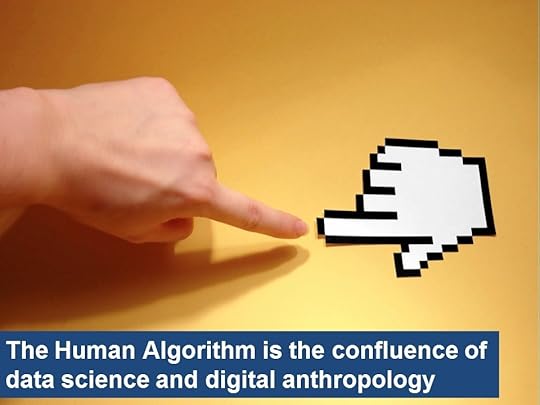
To identify them requires research and empathy. Generation C is not identifiable by demographics or generic personas. Generation C is a lifestyle…it’s everyone who lives a digital life. They’re connected and they’re in control. To evolve takes research that combines data science and digital anthropology.
To discovery them starts with studying more than the networks and technologies they use. Marketers must now partner with research teams to learn about behavior within and around networks, apps and devices. Doing so uncovers interests, preferences, expectations, and destinations. As a result, you are able to see and map out the new customer journey. And, you learn how to do more than just react to actions, sentiment, and trends. You’ll realize how to create meaningful customer journeys that improve experiences in existing and also new touch points…throughout the entire customer lifecycle.
Meet your new customers…Generation-C. You may in fact already be part of this movement. As such, you are the very customer you’re trying to reach.
Connect with me:
Twitter | LinkedIn | Facebook | Google+ |Youtube | Instagram
Faceless image: ShutterStock
May 21, 2014
Improving Customer Targeting and Personalization Through Social Identity
Guest post by Andrew Jones (@andrewjns), analyst at Altimeter Group covering Social Media and Customer Experience
Modern marketing is about more than just informing prospects and customers about products, but building relationships with them. The contextual insight available in social media offers an opportunity to better know and engage audiences with compelling, personalized content and experiences across channels. The following is a condensed excerpt from a forthcoming report.
The Fragmented Customer Journey
The customer journey has become incredibly fragmented, moving across various channels and devices, and saturated with more messages than ever. At the same time, customers have been empowered by new technology, increasingly expecting consistent, personal experiences. As a result, it has never been more necessary—yet also so complex—for brands to target and personalize customer messaging.
So why are marketers still sending untargeted, “batch and blast” emails, serving static web pages, and delivering the same ad to everyone (or just a small handful of segments)?
Lots of Data, Limited Context
With the proliferation of customer data in CRM, eCommerce, web analytics, loyalty programs, and other databases, enterprises have troves of information about their customers. Yet companies often understand customers in the context of their transactions and rarely as individuals. Customer identity today is a shattered mirror, with little pieces of it spread throughout the organization. Customer Service, sales, marketing, and loyalty each see a different piece of the profile. Without the right context, brands will never be able to build good relationships with customers.
The Value of Social Identity
Social media has played a major role in compounding the complexity of today’s customer journey, yet is also laden with customer insights unavailable on other channels. Suresh Vittal of Adobe says that, “Social yields sentiment, preference, and influence in ways that no other data source can.” Social profiles contain demographics, age, geography, affinity, influence, and more, while ongoing social signals can provide insight into a customer’s real-time context and needs.
For the purposes of this blog post, I’ll define Social Identity as, “The information about an individual available in social media, including profile data as well as ongoing social activity.” Social Identity can:
- Enable better targeting and personalization throughout the customer lifecycle
- Help provide consistent customer experiences across channels
- Provide a clear source of social media ROI
- Increase the efficiency of marketing and advertising budgets
Targeting and Personalization
In a recent interview, Jack Krawczyk, Pandora’s director of product management, said:
“Targeting users is basically the currency in data right now. Companies like Pandora and Facebook know users’ names and can track their media consumption or stated preferences across computers, tablets and phones, and have an advantage over companies relying on Web browsing cookies.”
Brands can access many of the same data points today, and those that do can better personalize content:
NFL.com is using social login to allow visitors to register and sign into its website. Not only does NFL.com then personalize the site experience, but it also sends highly personalized emails. For example, it sends offers for personalized jerseys based on a user’s favorite team and last name as their birthday approaches.
Social Media ROI
While the value of social media is typically hard to measure beyond vanity engagement metrics, other channels have metrics directly associated with ROI (e.g. open rates, CTR, downloads). Social Identity can directly impact those metrics:
Cox Media Group is increasing subscription rates by incorporating Social Identity to personalize the website experience, making sure users don’t see the same articles again and see those most related to their interests.
Improving Marketing and Ad Spend
Marketers are spending more on technology every year—especially technology that can engage customers in personal ways at scale, like marketing automation, email service providers, retargeting, and dynamic web content. Social Identity improves value of these tools by improving targeting capabilities:
Interscope Records has seen email open rates increase by over 9x in some cases, by sending customers messaging relevant to the artists they care about, based on their social signals.
In the report, I discuss ways to apply Social Identity throughout the Customer Lifecycle, but I’d like to know: how and when can additional customer insight help you build relationships with your customers? Please let me know in the comments.
Infinity Loop via Shutterstock
May 14, 2014
Q&A: The 7 Success Factors of Social Business Strategy
Last year, my Altimeter Group colleague Charlene Li and I published a series of research reports on the state and evolution of social business. In our research, we discovered that the most advanced businesses shared seven success factors in developing, launching, and measuring social business strategies. Our friends at Jossey-Bass asked us to turn it into an ebook and that we did!
The Seven Success Factors of Social Business Strategy
During the launch, we were interviewed by the Amazon team to dive deeper into the difference between social media and social business strategies. It also set the stage for our 2014 research track on Digital Transformation (report here.)
I’ve included the Amazon Q&A for you here…
What does it mean to be a social business?
A social business is more than social media and the Likes of Facebook, Twitter, Pinterest, et al. Yet, it’s a term that’s often confused with social media strategy. But, there’s an important difference between a social business and a social media strategy.
Each represent distinct qualities where “social” is simply a qualifier. In front of media, social is an adjective that describes the nature of channels, networks, or platforms that facilitate conversations online. When placed ahead of business, social articulates a philosophy or approach.
In this case, “social business” is a philosophy; a way of business where social technologies supported by new approaches facilitate a more open, engaged, collaborative foundation for how we work.
How do you convince companies to see social media as more than just “a necessary nuisance?”
The fact that social media and social business cause debate or even confusion after all these years is understandable. Many executives see social media as a novelty or a distraction for young adults and kids. They haven’t realized the impact of social networks because they either don’t have time, can’t see the value, find it difficult to keep up with all of the networks, or a combination of all of the above.
Coming back to the differences between social media and social business, it’s important for any social media or digital strategist to learn the language of the C-Suite. In the ebook, we share insights from several top executives to understand what it takes to convince them of the true opportunity that social promises. We heard time and time again that their priority and focus is driving business objectives, creating opportunities and solving problems. They don’t make decisions based on technology or trends, yet strategists tend to emphasize social media rather than business goals.
A social media strategy outlines how a business will employ social networks to engage customers or employees.
A social business strategy starts with a vision for how social media will improve customer and employee experiences and relationships and therefore aligns social media initiatives with business goals and opportunities. Technology thus becomes an enabler for a bigger mission and purpose.
Executives asked that we take into consideration a day in their life. They report to stakeholders and sometimes shareholders. They are measured on business performance. If you do your homework to understand their priorities and align social with business objectives, you’ll earn their attention. Add to that, customer expectations, preferences, and the opportunities and challenges with each and how you can help solve against them. By presenting social in this light, executives can’t help but at least support further research and ultimately pilot programs that lead to bigger initiatives.
In the end, you learn that a true social business strategy employs social as one of the primary channels, not the only channel, to deliver a consistent, connected, and additive experience online, through mobile and in the real world by modernizing and improving the complete customer and employee lifecycle.
What are some criteria that organizations should use to prioritize their social initiatives?
As mentioned earlier, social media strategies are often sparked by technology or trends. I’ve heard strategists focus on Pinterest because of its popularity not necessarily because there was a clear correlation between Pinterest users, behavior, and business opportunities. This is also true for most popular or emergent platforms.
When you begin with business objectives, social technology and the communities they reach, are evaluated against bona fide priorities that already have the buy-in of executives. In this case we look at business pillars to assess the criteria that contribute to the success of any organization, which can include sales, employee and customer satisfaction, brand resonance, NPS, et al. These pillars represent the primary measures for assessing value in the social business strategy process.
For example, each initiative should be assessed at the functional, line of business, or brand level. From there, ideas must tie together value to the organization (business goals) and also consider the team’s ability to execute. Evaluating ideas this way helps prioritize opportunities while uncovering needs, training, support or assets required to properly execute.
How important is it to get the C-suite on board with social business strategy?
In our research we learned that as social media permeates the enterprise, it typically does so from the marketing or communications department. Usually a social media champion rallies adoption within the organization. As social becomes more prevalent in society, more champions arise throughout the company seeing it as an opportunity to improve how they do things today. As it gains momentum, it creates an internal groundswell that eventually requires budget, resources, training, and governance to support expansion and introduce enterprise-wide standards and goals.
At this point, social usually hits a ceiling that requires executive sponsorship to truly transform how a company views social’s potential. Anyone experienced in change management will understand that systemic transformation occurs from the top-down. Earning buy-in, making the case, tying strategies to business objectives, learning the language of the C-Suite, this is how strategists can earn support and bring about the change they wish to see. This is true for more than social media of course. But in that regard, getting the C-Suite on board is imperative to launching productive social business initiatives.
Why do you recommend a three-year plan? Is that realistic, considering the rate of technology change?
If it’s one thing we can bet on, change is not only necessary, it’s slow to appreciate and ultimately unfold. A three-year plan is far enough out to plot a course for transformation but also tangible in the sense that real programs can be deployed now and over time to the benefit of customers, employees and the bottom line.
Remember, social business isn’t about technology; it’s about attaining goals and objectives by improving relationships, driving transactions, and enhancing experiences through channels of relevance. Technology and channels will always evolve and as such, they become enablers for a higher purpose. This is about the ongoing pursuit of relevance.
Visualizing the DNA of Successful Social Businesses
Via Vala Afshar…
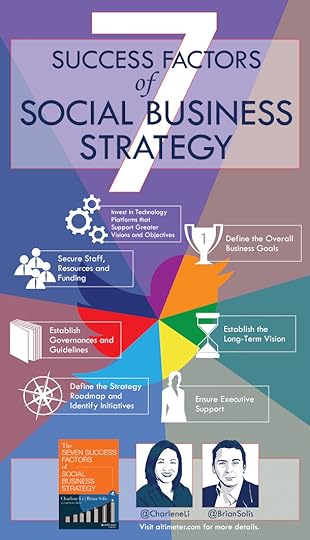
Via Mark Smiciklas…

Connect with me:
Twitter | LinkedIn | Facebook | Google+ |Youtube | Instagram


